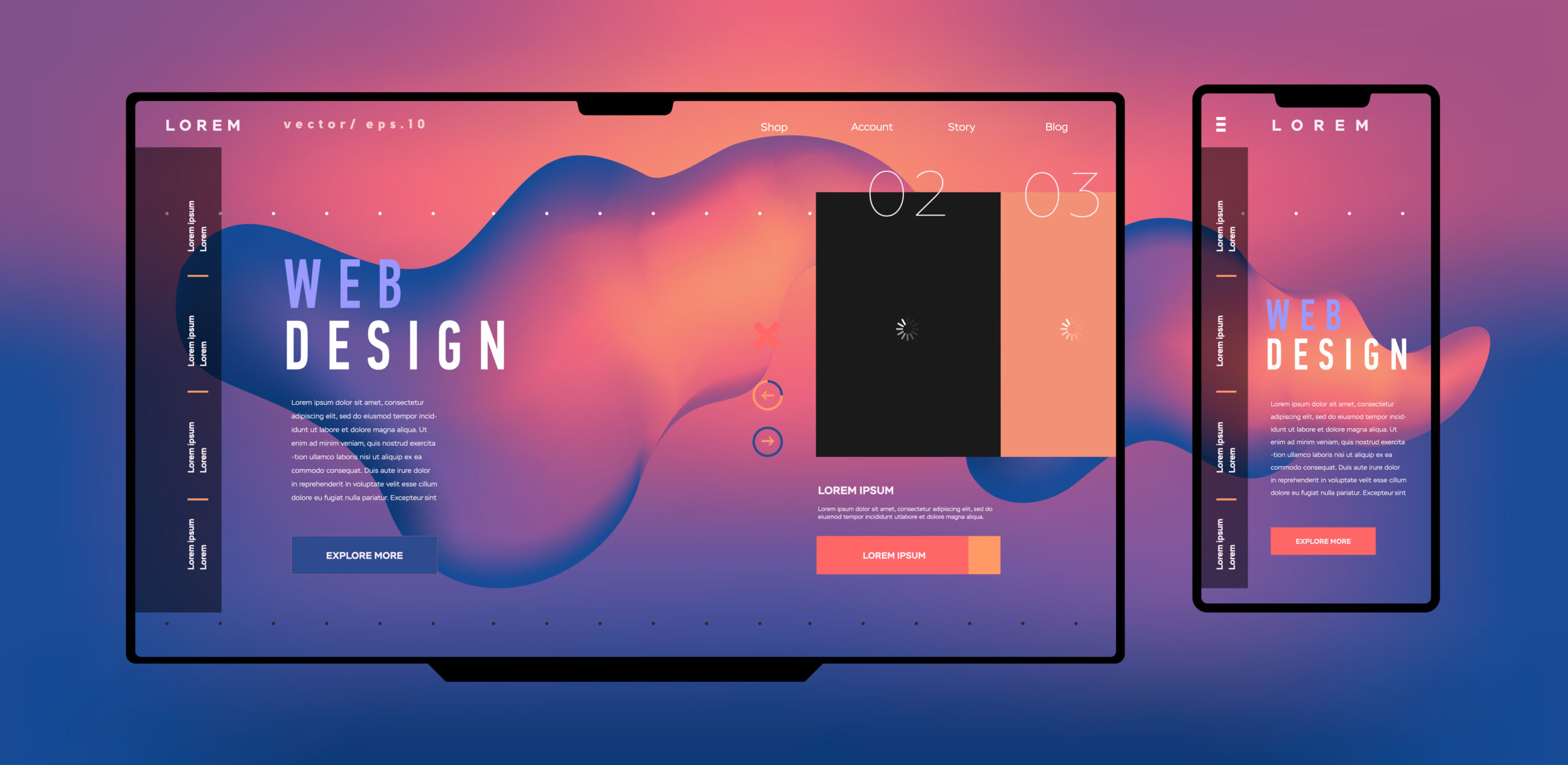The Significance of User Experience in Efficient Web Design Strategies
User experience (UX) offers as a keystone in effective web design approaches. It forms exactly how individuals connect with a website, affecting their complete satisfaction and chance of returning. A well-designed UX can enhance involvement via user-friendly navigating and responsive layouts. Overlooking these facets might lead to stress and raised bounce prices. Understanding the ins and outs of UX is vital for developers aiming to develop compelling digital experiences that reverberate with diverse audiences. What aspects absolutely drive effective user involvement?
Comprehending User Experience and Its Influence On Style
User experience (UX) is often viewed as a plain element of internet style, it basically forms exactly how individuals interact with a site. UX includes all elements of the user's communication, including use, availability, and general satisfaction. A positive UX cultivates engagement, motivating customers to explore the site and return in the future. Conversely, an adverse experience can lead to stress, causing high bounce rates and shed opportunities for conversion.
Style elements like layout, navigating, and content company play crucial roles in shaping this experience. Reliable UX layout expects user requirements and preferences, ensuring that info is visually appealing and quickly accessible. Furthermore, understanding user habits through analytics can give valuable understandings, notifying design decisions that enhance functionality. Eventually, a complete understanding of UX allows developers to create sites that not just draw in customers yet additionally promote meaningful interactions that straighten with business objectives and user assumptions.
Secret Principles of Efficient User Experience
Efficient user experience rests on a number of crucial principles that enhance site functionality and engagement. Intuitive navigating design, receptive design essentials, and the significance of visual hierarchy are essential components that add to a seamless communication in between individuals and web material. Comprehending these principles enables designers to produce even more straightforward and accessible electronic environments.
Intuitive Navigation Design
User-friendly navigation style serves as an important entrance to their total experience when users run into a website. Reliable navigation allows individuals to easily locate the info they seek, enhancing their communication with the website. Trick concepts consist of clear labeling, sensible company, and consistent placement of navigation aspects. Labels should be simple, permitting customers to forecast the content they will find. A well-structured hierarchy assists individuals comprehend the connection in between different sections, assisting them via the website seamlessly. Furthermore, responsive menus and easily accessible web links add to a liquid experience throughout tools. By focusing on intuitive navigating, developers can greatly reduce user disappointment and increase engagement, ultimately fostering a favorable perception of the internet site and its material.
Receptive Format Basics
A well-structured navigating system naturally results in the requirement for a responsive format, which is important in today's diverse digital landscape. A responsive design warranties that websites function seamlessly across different tools, consisting of desktop computers, tablets, and smartphones. This flexibility enhances user experience by allowing web content to be conveniently available and visually systematic, despite screen dimension. Key concepts of receptive layout include liquid grids, versatile pictures, and media queries, which assist in excellent viewing. Additionally, focusing on touch-friendly aspects enhances communication on mobile phones. By carrying out a receptive format, developers can suit customers' demands, lessen bounce prices, and rise engagement. Inevitably, a well-executed responsive design cultivates a positive user experience, urging visitors to discover the site better.
Aesthetic Pecking Order Significance
Aesthetic pecking order plays a vital duty in leading individuals with a website, ensuring that critical info records their interest first. By tactically utilizing dimension, color, spacing, and comparison, developers can produce a clear path for customers to adhere to. Bigger elements commonly draw the eye, indicating their relevance, while contrasting colors can highlight telephone calls to activity. In addition, regular positioning and group of related material boost understanding, making navigating intuitive. Effective use visual pecking order not just boosts usability yet additionally supports the overall visual of the website, fostering a favorable user experience. When individuals can quickly identify one of the most crucial details, they are a lot more most likely to involve with the content, resulting in boosted satisfaction and communication with the web site.
The Duty of Use in Web Design
Usability plays a necessary function in web design, especially with navigating simpleness and adherence to accessibility criteria. Reliable navigation improves user contentment by enabling site visitors to find details promptly and without effort. Meeting accessibility requirements assures that all customers, regardless of their abilities, can successfully interact with the website.
Navigating Simpleness
Simplicity in navigation stands as a cornerstone of efficient web design, substantially influencing user experience. A structured navigating system allows users to locate details rapidly and without effort, lowering irritation and enhancing satisfaction. Clear labeling and rational structure are essential elements, assisting customers effortlessly through the site. Redundant links or extremely complicated food selections can disorient individuals, resulting in boosted bounce prices. In addition, mobile responsiveness needs to be thought about, making certain navigation continues to be simple throughout devices. Focusing on important web pages and lessening clutter better supports user engagement. Reliable navigation not only promotes a positive experience but likewise motivates customers to discover the website extra completely, ultimately resulting in greater conversion prices. In this respect, navigating simplicity works as a critical factor in the general performance of web design approaches.
Access Criteria
User interaction is greatly improved when internet sites stick to access requirements, ensuring that all customers, despite their abilities, can navigate and communicate properly. Conformity with these standards not just expands the target market yet additionally enhances general user satisfaction. Accessible style integrates attributes such as message choices for photos, keyboard navigating, and adequate shade comparison, which help with use by individuals with handicaps. Additionally, executing these requirements can positively impact search engine optimization (SEARCH ENGINE OPTIMIZATION) by enhancing website framework and quality. As web design evolves, prioritizing availability ends up being crucial in cultivating a comprehensive electronic atmosphere. By embracing these standards, designers add to a much more fair net, ultimately driving user commitment and interaction.
Value of Responsive Layout for User Involvement
As customers increasingly accessibility internet sites with a variety of gadgets, the significance of receptive layout ends up being paramount for involving users successfully. Receptive style assurances that a website adjusts perfectly to various display dimensions, providing a perfect watching experience regardless of the tool used. This adaptability improves user involvement by assisting in much easier navigating and interaction with web content.
When users come across a website that is responsive, they are most likely to stay longer, explore additionally, and return in the future. A well-designed hop over to here responsive layout lessens the irritation frequently related to scrolling and zooming on smaller screens, consequently reducing bounce prices. Furthermore, responsive design can positively influence online search engine positions, as search engines prioritize mobile-friendly internet sites. In today's digital landscape, where mobile use remains to climb, implementing receptive style is not just useful, but important for maintaining user engagement and ensuring a positive experience across all gadgets.
Enhancing Load Times for Better User Complete Satisfaction

To improve lots times, internet developers ought to prioritize optimizing images, leveraging browser caching, and lessening HTTP requests. Furthermore, employing Content Shipment Networks (CDNs) can speed up content distribution by distributing it throughout numerous geographic places. Enhancing code, such as pressing CSS and JavaScript documents, even more adds to faster packing rates.
Ultimately, a commitment to boosting lots times not just improves user contentment however also reinforces brand name commitment and enhances the likelihood of repeat brows through. A swift, smooth experience is essential for keeping individuals and fostering positive communications.
The Impact of Visual Hierarchy on User Communication
Visual pecking order acts as a necessary aspect in leading user communication on a site. By organizing web content in such a way that prioritizes info visually, developers can affect just how customers involve and browse with a website. This power structure is established with various layout methods, consisting of dimension, comparison, spacing, and shade. For circumstances, larger fonts or bold shades accentuate crucial elements, such as telephone calls to activity or headlines, while controlled shades and smaller sized font styles can suggest subordinate details.
Effective aesthetic hierarchy assists customers swiftly determine what is crucial, decreasing cognitive tons and improving usability. It permits user-friendly navigating, making it easier for individuals to discover what they require without irritation. As customers connect with a website, a well-structured aesthetic pecking order promotes a much more enjoyable experience, ultimately resulting in greater involvement and conversion rates. Developers have to focus on these principles to create a effective check it out and user-centered internet atmosphere.
Measuring User Experience: Methods and devices

Often Asked Concerns
Just How Can I Improve My Site's User Experience on a Budget?
To improve an internet site's user experience on a spending plan, one can enhance page tons rate, simplify navigating, carry out receptive style, boost content clearness, and gather user responses for continuous improvements, making sure a satisfying site visitor experience.
What Are Common User Experience Mistakes to Avoid in Web Design?
Usual user experience errors in web design consist of messy layouts, inadequate navigation, sluggish filling times, absence of mobile responsiveness, overlooking access, inconsistent branding, and stopping working to prioritize user responses - agency for web design. Each can considerably prevent general website performance
Exactly how Typically Should I Update My Site for Better User Experience?
Internet sites should be upgraded routinely, ideally every couple of months, to maintain perfect user experience. Regular updates assist address usability concerns, rejuvenate content, and adjust to changing user requirements, making sure the site remains relevant and interesting.

Can User Experience Influence SEO Rankings on My Website?
User experience can significantly impact search engine optimization positions, as search engines focus on sites that supply smooth navigating, fast filling times, and interesting content. A positive user experience can bring about reduced bounce rates and higher search exposure.
What Function Does Accessibility Play in User Experience Layout?
Accessibility plays a vital duty in user experience design by ensuring that all people, despite capabilities, can browse and connect with a web site properly. This inclusivity improves overall satisfaction and engagement amongst varied users.
User experience Continue (UX) is usually viewed as a mere facet of internet style, it fundamentally shapes just how individuals communicate with a web site. User engagement is considerably boosted when internet sites adhere to access standards, guaranteeing that all users, no matter of their abilities, can navigate and engage properly. Gauging user experience (UX) is vital for understanding exactly how effectively an internet site meets the demands of its users. In addition, functionality screening, where genuine users browse the site while viewers keep in mind problems, uses straight responses on user experience. Usual user experience mistakes in web style include cluttered formats, poor navigation, sluggish loading times, lack of mobile responsiveness, overlooking access, inconsistent branding, and stopping working to prioritize user comments.